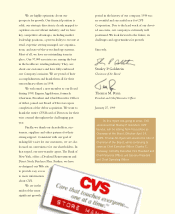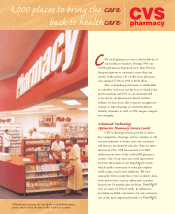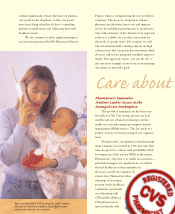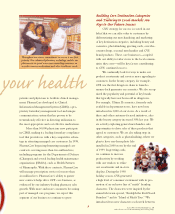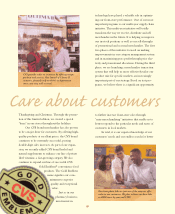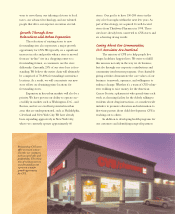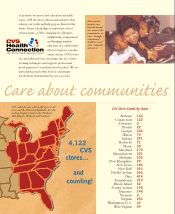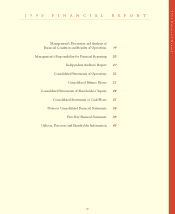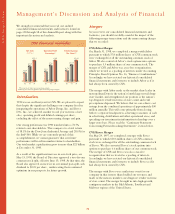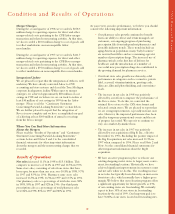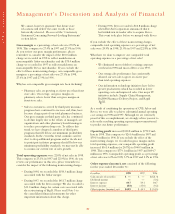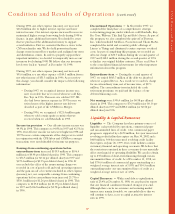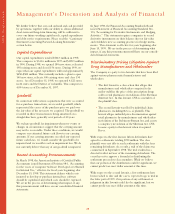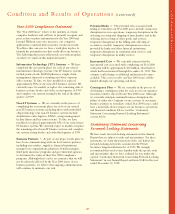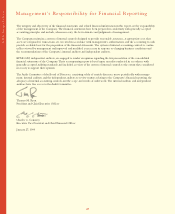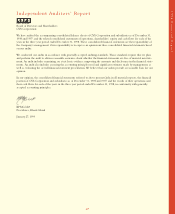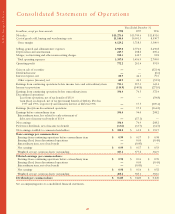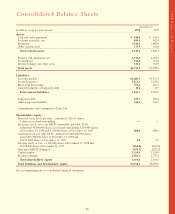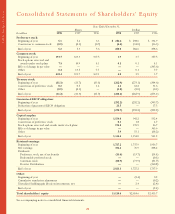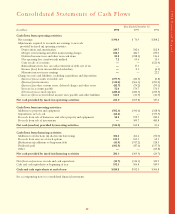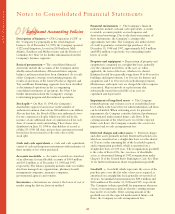CVS 1998 Annual Report Download - page 18
Download and view the complete annual report
Please find page 18 of the 1998 CVS annual report below. You can navigate through the pages in the report by either clicking on the pages listed below, or by using the keyword search tool below to find specific information within the annual report.
16
CVS Corporation
•During 1996, Revco recorded a $12.8 million charge
when Rite Aid Corporation announced that it
had withdrawn its tender offer to acquire Revco.
This event took place before we merged with Revco.
If you exclude the effect of these nonrecurring charges,
comparable total operating expenses as a percentage of net
sales were 20.9% in 1998, 21.9% in 1997 and 22.8% in 1996.
What have we done to improve our comparable total
operating expenses as a percentage of net sales?
•We eliminated most of Arbor’s existing corporate
overhead in 1998 and most of Revco’s in 1997.
•Our strong sales performance has consistently
allowed our net sales to grow at a faster pace
than total operating expenses.
•Our information technology initiatives have led to
greater productivity, which has resulted in lower
operating costs and improved sales. Our major IT
initiatives include: Supply Chain Management,
Rx2000 Pharmacy Delivery Project, and Rapid
.
As a result of combining the operations of CVS, Arbor and
Revco, we were able to achieve substantial annual operating
cost savings in 1998 and 1997. Although we are extremely
proud of this accomplishment, we strongly advise you not to
rely on the resulting operating expense improvement trend
to predict our future performance.
Operating profit increased $510.8 million to $772.2 mil-
lion in 1998. This compares to $261.4 million in 1997 and
$591.9 million in 1996. If you exclude the effect of the
nonrecurring charges we recorded in gross margin and in
total operating expenses, our comparable operating profit
increased $161.4 million (or 20.7%) to $940.5 million in
1998. This compares to $779.1 million in 1997 and $604.7
million in 1996. Comparable operating profit as a percentage
of net sales was 6.2% in 1998, 5.7% in 1997 and 5.1% in 1996.
Other expense (income), net consisted of the following
for the years ended December 31:
In millions 1998 1997 1996
Gain on sale of securities $—$—$(121.4)
Dividend income ——(5.6)
Interest expense 69.7 59.1 84.7
Interest income (8.8) (15.0) (9.2)
Other expense (income), net $60.9 $ 44.1 $ (51.5)
We cannot, however, guarantee that future store
relocations will deliver the same results as those
historically achieved. Please read the “Cautionary
Statement Concerning Forward-Looking Statements”
section below.
Gross margin as a percentage of net sales was 27.0% in
1998. This compares to 27.0% in 1997 and 27.9% in 1996.
As you review our gross margin performance, please
remember to consider the impact of the $10.0 million
charge we recorded in 1998 to reflect markdowns on
noncompatible Arbor merchandise and the $75.0 million
charge we recorded in 1997 to reflect markdowns on
noncompatible Revco merchandise. If you exclude the
effect of these nonrecurring charges, our comparable gross
margin as a percentage of net sales was 27.1% in 1998,
27.6% in 1997 and 27.9% in 1996.
Why has our comparable gross margin rate been declining?
•Pharmacy sales are growing at a faster pace than front
store sales. On average, our gross margin on
pharmacy sales is lower than our gross margin on
front store sales.
•Sales to customers covered by third party insurance
programs have continued to increase and, thus, have
become a larger part of our total pharmacy business.
Our gross margin on third party sales has continued
to decline largely due to the efforts of managed care
organizations and other pharmacy benefit managers
to reduce prescription drug costs. To address this
trend, we have dropped a number of third party
programs that fell below our minimum profitability
standards. In the event this trend continues and we
elect to drop additional programs and/or decide not
to participate in future programs that fall below our
minimum profitability standards, we may not be able
to sustain our current rate of sales growth.
Total operating expenses were 22.0% of net sales in 1998.
This compares to 25.1% in 1997 and 22.9% in 1996. As you
review our performance in this area, please remember to
consider the impact of the following nonrecurring charges:
•During 1998, we recorded the $158.3 million charge
associated with the Arbor merger.
•During 1997, we recorded the $411.7 million charge
associated with the Revco merger. We also recorded a
$31.0 million charge for certain costs associated with
the restructuring of Big B. Please read Note 3 to
the consolidated financial statements for other
important information about this charge.
Management’s Discussion and Analysis of Financial


